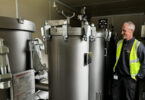As Europe edges closer to regulating the production of PVDF membranes—key contributors to the toxic PFAS, ‘forever chemicals’—the water industry finds itself at a critical crossroads. The European Chemicals Agency (ECHA) is actively assessing the ban on fully fluorinated substances and is expected to announce details regarding the restriction of PVDF in 2025. If implemented, this decision could be the long-overdue catalyst needed to accelerate the adoption of ceramic membranes, driving the industry toward a more sustainable future. An October 29, 2024, article from Global Water Intelligence (GWI) titled ‘Europe’s planned PFAS ban threatens global membrane markets‘ highlights the disruption such a ban could have on the membrane market. However, it also emphasizes the opportunity for the industry to transition to more sustainable alternatives, such as ceramic membranes, which are seen as safer and more environmentally friendly in comparison to PVDF-based membranes.

Julius Gloeckner, Chief Growth Officer, CERAFILTEC
The urgency of this shift becomes even more apparent when considering the human health impacts linked to PFAS contamination as prevalently reported in studies around the world. We have an obligation to act—not only for ourselves but for our children and future generations. The shift is needed now, as bioaccumulation continues in our bodies, and each day of delay means further buildup of these harmful chemicals in our ecosystems.
Recent findings from the German Federal Environment Agency—the “Umweltbundesamt”—revealed that PFAS levels were alarmingly high in the blood of children and adolescents. In up to a quarter of those tested, concentrations were so elevated that “health effects could no longer be ruled out with sufficient certainty.” This is just one of hundreds of studies outlining the concerning health risks of PFAS, highlighting the very real human cost linked to these chemicals.
PVDF membranes contribute to the environmental burden of PFAS, due to their carbon-fluorine bonds, making them particularly hazardous to human health. Additionally, they contribute to plastic pollution, which negatively impacts the environment and ultimately human health.
Ceramic membranes offer a far superior solution: unmatched durability, sustainability, and performance. Yet their mainstream adoption has been rather slow. Why? A risk-averse industry and misaligned incentives have allowed conventional polymeric membranes to remain entrenched. But sticking to what’s familiar is depriving us of the transformative benefits that only widespread adoption can unlock.
So why are we hesitating? What’s keeping the industry from embracing a technology that promises better outcomes for water treatment, the environment, and future generations?
The Case Against PVDF: What’s at Stake?
PVDF membranes are closely linked to PFAS—the so-called ‘forever chemicals’—that are pervasive, persistent, and toxic. PFAS are estimated to take over 1,000 years to degrade, staying in the environment for centuries, gradually accumulating in ecosystems, in the food chain. This poses a significant threat to our well-being.
PFAS exposure has been linked to a variety of health issues, including cancer, immune system suppression, and developmental delays in children. In 2023, the European Chemicals Agency (ECHA) released a report highlighting the severe health impacts and the need for urgent regulatory action. Imagine these toxic substances accumulating in our bodies and, eventually, in our children’s children. The full spectrum of long-term effects are still unknown, but the symptoms we already observe—such as immune dysfunction and hormonal disruptions—are enough to demand immediate change.
Our plastic waste problem is similarly profound. The annual use of polymeric membranes produces plastic waste equivalent to 3.2 billion water bottles, enough to stack to the moon and back. In 2022 alone, global plastic production exceeded 390 million tons per year, and polymeric membrane waste is a significant contributor. This plastic waste does not just disappear—it proliferates through ecosystems, eventually finding its way back into us. According to the Ellen MacArthur Foundation, studies estimate that by 2050, there could be more plastic than fish in the oceans by weight. The health and environmental consequences are staggering, and every year we delay change, the problem compounds.
Ceramic Membranes: Better for People, Planet, and Profit
The superiority of ceramic membranes is blatantly obvious. They are fundamentally better for people, the planet, and profit. Ceramic membranes already demonstrate their clear advantages:
- Total Cost of Ownership: Ceramic membranes provide a superior total cost of ownership for end users. Their durability and extended lifespan translate into lower maintenance costs and fewer replacements.
- Reliability: As source water conditions continue to worsen, ceramic membranes offer more reliable operation, withstanding the challenges that are increasingly common in today’s environment.
- Sustainability: With a much longer service life and the ability to be reused & recycled, ceramic membranes are not contributing to the proliferating plastic challenge. They are a sustainable solution, designed to evolve with our environmental needs.
The Problem: Misaligned Incentives and Industry Inertia
So, what is holding us back? Notoriously slow to embrace change, the water industry suffers from an intricate web of misaligned incentives, inertia, and fragmented mechanics of adoption:
- Gatekeepers with Misaligned Incentives: Consultants, who are often the gatekeepers of technology adoption, are incentivized to stick to what they know. Their focus is on avoiding risk rather than embracing new, potentially superior technologies. They are not rewarded for choosing innovation; they can only lose if something goes wrong. Why take a risk for which there is no reward?
- Lack of Standardization: There is no standardized approval process across borders and applications. A reference for ceramic membranes in one region does not easily translate to acceptance elsewhere. It’s as frustrating as proving that a perfectly functional car works equally well on all roads, only to be asked to prove it over and over again.
- Information Gaps: There are limited platforms for information sharing, making it difficult to cross-pollinate knowledge and experiences with new technologies.
- Conservative Industry Culture: Naturally, industry participants are conservative, habituated to familiar practices. Short-term economics often take precedence, leading to missed opportunities to stimulate long-term innovation.
Paul O’Callaghan, Founder and CEO, BlueTech Research, in his 2020 PhD thesis ‘Dynamics of Water Innovation’, discussed how difficult it is for new water technologies to gain traction, especially with gatekeepers focusing on minimizing risk. The problem is not that consultants or decision-makers are ill-intentioned; they are simply navigating within a system that discourages deviation from the status quo.
The Role of Regulation: A Vital Mechanism for Change
In such a misaligned setup, regulations must play a crucial role in orchestrating change. Especially in water treatment—arguably one of the most vital industries for humanity—we need regulatory mechanisms that align incentives to drive, not stall, innovation. The forthcoming PVDF ban could be the catalyst we need to overcome these headwinds.
History shows that regulations can drive impactful transitions. Take the LED light bulb—initially pricier than incandescent bulbs, yet far more efficient and long-lasting. The U.S. Energy Policy Act (2005) and Energy Star rebates encouraged early adoption, while the EU’s Ecodesign Directive (2009) phased out inefficient bulbs, making LEDs a preferred choice. By 2012, LEDs had reached mainstream status, allowing up to 80% energy savings and reducing lighting costs by as much as 90% over the lifespan. Regulations were crucial in accelerating this shift, allowing the environmental and economic benefits to be realized far sooner.
Another example is the analog-to-digital switch in broadcasting, initiated in 2006 and completed by 2012. Regulatory mandates accelerated this shift, requiring broadcasters to adopt digital, which enabled sharper images, better sound, and more channels, greatly enhancing the viewer experience. By freeing up spectrum for wireless broadband, regulations maximized resources and allowed for high-definition, multiplexed content, achieving broader access and improved quality faster than organic adoption would have allowed
Similarly to LED lighting and digital broadcasting, ceramic membranes represent a superior technology that faces challenges in widespread adoption due to industry dynamics and market inertia. As a viable alternative to PVDF and other polymeric membranes, ceramic membranes have already been successfully implemented in numerous drinking water and wastewater facilities. Like the LED and digital broadcasting transitions, adopting ceramic membranes brings significant benefits that regulations could help accelerate. With strategic regulatory support, this shift could occur more rapidly and effectively, enabling the industry to realize substantial economic and environmental gains sooner and with broader impact.
Accelerated Transition: Bringing Stakeholders Along in a Well-Paced Switch
How would such a transition look? While acceleration is necessary, it cannot happen overnight either. A knee-jerk change would risk poor implementation and bad references. Capacity ramp-up is not the bottleneck; the real challenge is ensuring that key stakeholders—consultants, integrators, developers, and end users—are brought along effectively, while avoiding inexperienced companies that could create poor references.
Ceramic membranes can replace polymeric membranes across all applications—there is no application that polymeric membranes can handle that ceramic cannot. Direct replacements and upgrades of existing polymeric membrane systems are not only possible, but have already been implemented in dozens of cases, facilitating a smoother transition to advanced solutions. An accelerated but well-paced, full transition over the next 5-10 years would allow stakeholders to gain hands-on experience, ensuring the successful adoption of ceramic membrane technology.
Experienced ceramic membrane providers can cultivate standards in collaboration with leading industry participants, ensuring the successful integration of ceramic technology. As new competitors emerge, the industry will evolve, and the best providers will rise to the top, ensuring that the benefits bear fruit for everyone involved.
The Ripple Effect of Innovation: Imagine What’s Possible
Technology transitions are needed to ultimately unlock the full benefits of next-generation solutions. Think of the transition from the typewriter to the personal computer. Typewriters did the job but were fundamentally constrained. PCs initially offered incremental benefits, but it took critical mass and mainstream adoption for further innovation to flourish, driving PC developments beyond initial expectations. The mainstream adoption of PCs didn’t just replace typewriters; it redefined productivity and reshaped how we communicate, work, and live. By 1981, IBM introduced the first mass-market PC, and by the late 1990s, personal computers were a household staple. Today, it’s impossible to envision a world without them.
Imagine what is possible with ceramic membranes once mainstream adoption is achieved. With matured competition, substantial R&D budgets, and further process innovation, ceramic technology will reshape the water industry. The benefits we will reap from ceramic membranes will be unparalleled compared to today’s status quo of polymeric membranes. It is in all of our interests to accelerate this transition.
Water is one of the most critical sectors for our future, and every stakeholder—from regulators and investors to end users, consultants, integrators, and technology providers—has a unique opportunity to drive meaningful change. By making bold decisions, rethinking how we incentivize innovation, and taking meaningful action, we can accelerate progress that is not only necessary but also immensely rewarding: crucial for people, the planet, and profit. We ought to create a transformative shift that future generations will thank us for. Now is the time.
Author: Julius Gloeckner, Chief Growth Officer, CERAFILTEC, julius@cerafiltec.com
If interested in learning more or contributing to this transformative journey, visit CERAFILTEC or contact us directly.
Follow us on LinkedIn to stay updated and join the conversation.








